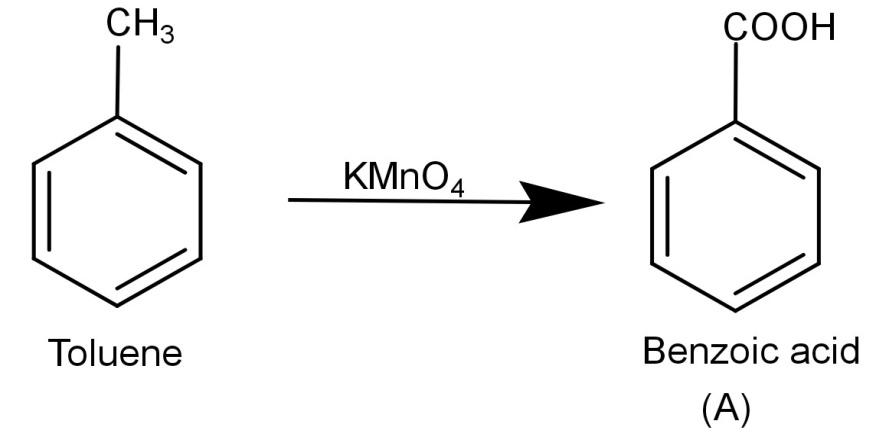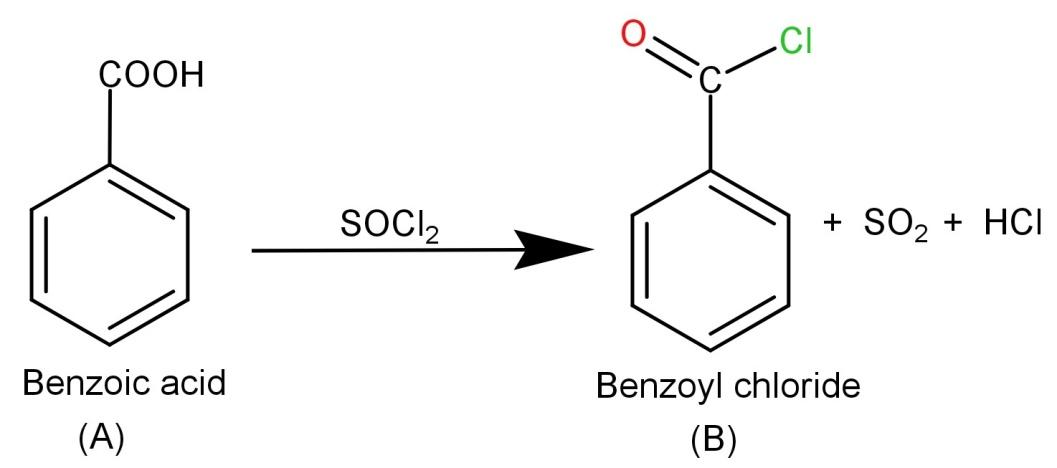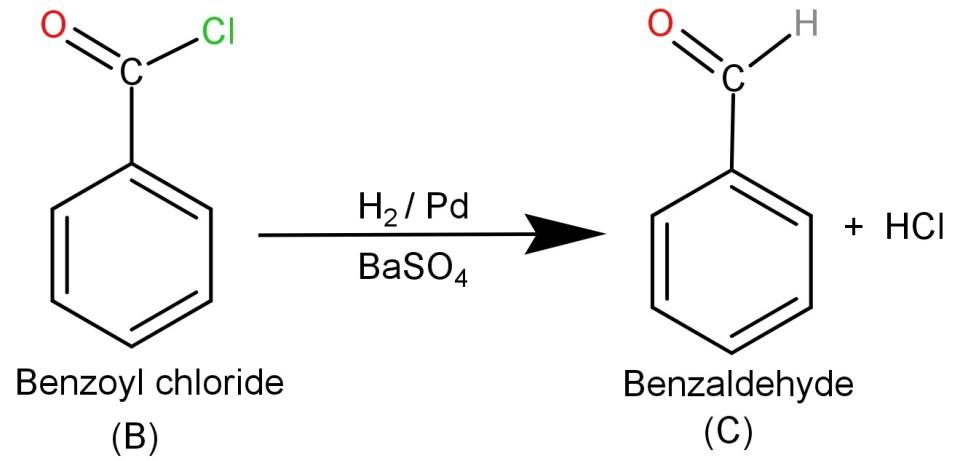
In the following sequence of reactions: Toluene$\xrightarrow{{KMn{O_4}}}$A$\xrightarrow{{SOC{l_2}}}$B$\xrightarrow[{BaS{O_4}}]{{{H_2}/Pd}}$C; then product C is:
(A) ${C_6}{H_5}COOH$
(B) ${C_6}{H_5}C{H_3}$
(C) ${C_6}{H_5}C{H_2}OH$
(D) ${C_6}{H_5}CHO$
Answer
466.2k+ views
Hint: We should know that $KMn{O_4}$ is an oxidising agent, $SOC{l_2}$ is an acylating agent and ${H_2}/Pd$ or $BaS{O_4}$ are reducing agents which cause the Rosenmund’s reduction.
Complete step by step answer:
-In this question we need to go step by step for each reactant and first find A, then B and then C as shown in the reaction: Toluene$\xrightarrow{{KMn{O_4}}}$A$\xrightarrow{{SOC{l_2}}}$B$\xrightarrow[{BaS{O_4}}]{{{H_2}/Pd}}$C
-Now let us begin by finding (A). We know that the initial reactant is toluene (${C_6}{H_5} - C{H_3}$) and $KMn{O_4}$ is a strong oxidizing agent and it oxidizes toluene to benzoic acid. The reaction is shown below:

-Now we need to react (A) Benzoic acid with $SOC{l_2}$ (Thionyl chloride). The thionyl chloride converts carboxylic acid to acid chloride and hence it will convert benzoic acid to benzoyl chloride. The reaction is shown below:

-Finally the product (B) Benzoyl chloride needs to be reacted with ${H_2}/Pd$ or $BaS{O_4}$. They are reducing agents and hence Rosenmund reduction occurs which causes the conversion of benzoyl chloride to Benzaldehyde. So the final product is Benzaldehyde and the involved reaction is:

From this we know that (C) is Benzaldehyde (${C_6}{H_5}CHO$)
So, the correct answer is “Option D”.
Note: Since Benzaldehyde is a colourless liquid with a characteristic almond like odour, it can be used as a bitter component of almond oil and is also used to impart artificial almond flavour to foods and some other scented products.
Complete step by step answer:
-In this question we need to go step by step for each reactant and first find A, then B and then C as shown in the reaction: Toluene$\xrightarrow{{KMn{O_4}}}$A$\xrightarrow{{SOC{l_2}}}$B$\xrightarrow[{BaS{O_4}}]{{{H_2}/Pd}}$C
-Now let us begin by finding (A). We know that the initial reactant is toluene (${C_6}{H_5} - C{H_3}$) and $KMn{O_4}$ is a strong oxidizing agent and it oxidizes toluene to benzoic acid. The reaction is shown below:

-Now we need to react (A) Benzoic acid with $SOC{l_2}$ (Thionyl chloride). The thionyl chloride converts carboxylic acid to acid chloride and hence it will convert benzoic acid to benzoyl chloride. The reaction is shown below:

-Finally the product (B) Benzoyl chloride needs to be reacted with ${H_2}/Pd$ or $BaS{O_4}$. They are reducing agents and hence Rosenmund reduction occurs which causes the conversion of benzoyl chloride to Benzaldehyde. So the final product is Benzaldehyde and the involved reaction is:

From this we know that (C) is Benzaldehyde (${C_6}{H_5}CHO$)
So, the correct answer is “Option D”.
Note: Since Benzaldehyde is a colourless liquid with a characteristic almond like odour, it can be used as a bitter component of almond oil and is also used to impart artificial almond flavour to foods and some other scented products.
Recently Updated Pages
Using the following information to help you answer class 12 chemistry CBSE

Basicity of sulphurous acid and sulphuric acid are

Master Class 12 Economics: Engaging Questions & Answers for Success

Master Class 12 Maths: Engaging Questions & Answers for Success

Master Class 12 Biology: Engaging Questions & Answers for Success

Master Class 12 Physics: Engaging Questions & Answers for Success

Trending doubts
What is the Full Form of PVC, PET, HDPE, LDPE, PP and PS ?

Figure shows a conducting loop ABCDA placed in a uniform class 12 physics CBSE

Explain with a neat labelled diagram the TS of mammalian class 12 biology CBSE

The first general election of Lok Sabha was held in class 12 social science CBSE

How do you convert from joules to electron volts class 12 physics CBSE

The term ecosystem was coined by a EP Odum b AG Tansley class 12 biology CBSE




